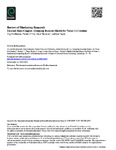Please use this identifier to cite or link to this item:
http://thuvien.due.udn.vn:8080/dspace/handle/TVDHKT/20595Full metadata record
| DC Field | Value | Language |
|---|---|---|
| dc.contributor.author | Storbacka, Kaj | - |
| dc.contributor.author | Frow, Pennie | - |
| dc.contributor.author | Nenonen, Suvi | - |
| dc.contributor.author | Payne, Adrian | - |
| dc.date.accessioned | 2015-06-29T10:22:01Z | - |
| dc.date.available | 2015-06-29T10:22:01Z | - |
| dc.date.issued | 2012 | - |
| dc.identifier.citation | p. 51 - 78 | vi |
| dc.identifier.issn | 1548-6435 | - |
| dc.identifier.uri | http://thuvien.due.udn.vn:8080/dspace/handle/TVDHKT/20595 | - |
| dc.description.abstract | Purpose – The aim of this chapter is to investigate how a focal market actor may design or redesign business models for improved value co-creation. Findings – We posit that value is co-created in use as actors integrate resources in practices, which makes practices a fundamental unit of value creation. Greater density of resources, relevant to a specific practice and to the goals or mission of the actor, corresponds to greater value. The role of a provider is to support other actors in their value-creation processes by providing resources that ‘fit’ into their practices. We identify 12 categories of business model design elements that need to be defined and developed in parallel. We conclude that a focal actor needs to strive for both intra-actor and inter-actor (meso-level) configurational fit of business model elements in order to enable purposeful co-creation in specific practices. Finally, we propose that meso-level configurations develop in a threephase process of origination, mobilization and stabilization. A focal actor wishing to improve co-creation in a network needs to develop value propositions not only for customers but also for other actor domains. verall, the performative power of a market actor is dependent on its network position, the relative strength of its business model and the actor’s ability to author compelling meanings. Originality – The research contributes to the discussion on value cocreation by identifying three shifts in the unit of analysis: (1) we argue that use-value is co-created as actors integrate resources in practices, rendering practices a fundamental unit of analysis, (2) as practices are outcomes of business models, we identified business model design as a key unit of analysis for the improvement of value co-creation and (3) our view on business models is network-centric and we focus on how to introduce new business model elements in a specific actor network. Practical implications – The realization of the fact that value creation occurs in networks of interdependent actors pinpoints the need for increased transparency both between functional silos and between actors. The business model framework identifies 12 design elements, which can act as a ‘checklist’ for managers wanting to engage in co-creative business models. | vi |
| dc.language.iso | en_US | vi |
| dc.publisher | Emerald | vi |
| dc.relation.ispartofseries | Review of Marketing Research;Volume 9 | - |
| dc.subject | Use-value | vi |
| dc.subject | co-creation | vi |
| dc.subject | business mode | vi |
| dc.subject | configuration | vi |
| dc.title | Review of Marketing Research Emerald Book Chapter: Designing Business Models for Value Co-Creation | vi |
| dc.type | Article | vi |
| Appears in Collections: | Bách Khoa toàn thư Việt Nam | |
Files in This Item:
| File | Description | Size | Format | |
|---|---|---|---|---|
| 235307825.pdf | 28.66 MB | Adobe PDF |  Sign in to read |
Items in DSpace are protected by copyright, with all rights reserved, unless otherwise indicated.